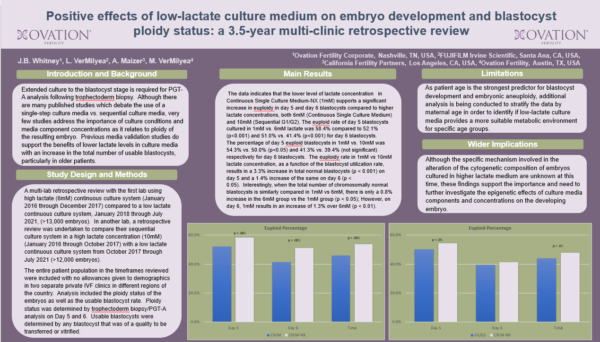Authors: J.B. Whitney1, L. Watson2, A. Maizar3, M. VerMilyea4.
Study question:
Can lower concentrations of lactate in culture medium have a positive effect on day 5 and day 6 blastocyst ploidy determined by PGT-A?
Summary answer:
Embryos cultured to the blastocyst stage in medium containing 1mM concentration of lactate vs. 6mM or 10mM are significantly more likely to be euploid.
What is known already:
Extended culture to the blastocyst stage is required for PGT-A analysis following trophectoderm biopsy. Although there are many published studies which debate the use of a single-step culture media vs. sequential culture media, very few studies address the importance of culture conditions and media component concentrations as it relates to ploidy of the resulting embryo. Previous media validation studies do support the benefits of lower lactate levels in culture media with an increase in the total number of usable blastocysts, particularly in older patients.
Study design, size, duration:
A multi-lab retrospective review with the first lab using high lactate (6mM) continuous culture system (January 2016 through December 2017) compared to a low lactate continuous culture system, January 2018 through July 2021, (>13,000 embryos). In another lab, a retrospective review was undertaken to compare their sequential culture system in a high lactate concentration (10mM) (January 2016 through October 2017) with a low lactate continuous culture system from October 2017 through July 2021 (>12,000 embryos).
Participants/materials, setting, methods:
The entire patient population in the timeframes reviewed were included with no allowances given to demographics in two separate private IVF clinics in different regions of the country. Analysis included the ploidy status of the embryos as well as the usable blastocyst rate. Ploidy status was determined by trophectoderm biopsy/PGT-A analysis on Day 5 and 6. Usable blastocysts were determined by any blastocyst that was of a quality to be transferred or vitrified.
Main results and the role of chance:
Our data indicates that the lower level of lactate concentration in Continuous Single Culture Medium-NX (1mM) supports a significant increase in euploidy in day 5 and day 6 blastocysts compared to higher lactate concentrations, both 6mM (Continuous Single Culture Medium) and 10mM (Sequential G1/G2). The euploid rate of day 5 blastocysts cultured in 1mM vs. 6mM lactate was 58.4% compared to 52.1% (p<0.001) and 51.0% vs. 41.4% (p<0.001) for day 6 blastocysts. The percentage of day 5 euploid blastocysts in 1mM vs. 10mM was 54.3% vs. 50.0% (p<0.05) and 41.3% vs. 39.4% (not significant) respectively for day 6 blastocysts. The euploidy rate in 1mM vs 10mM lactate concentration, as a function of the blastocyst utilization rate, results in a 3.3% increase in total normal blastocysts (p < 0.001) on day 5 and a 1.4% increase of the same on day 6 (p < 0.05). Interestingly, when the total number of chromosomally normal blastocysts is similarly compared in 1mM vs 6mM, there is only a 0.8% increase in the 6mM group vs the 1mM group (p < 0.05); However, on day 6, 1mM results in an increase of 1.3% over 6mM (p < 0.01).
Limitations, reasons for caution:
As patient age is the strongest predictor for blastocyst development and embryonic aneuploidy, additional analysis is being conducted to stratify the data by maternal age in order to identify if low-lactate culture media provides a more suitable metabolic environment for specific age groups.
Wider implications of the findings:
Although the specific mechanism involved in the alteration of the cytogenetic composition of embryos cultured in higher lactate medium are unknown at this time, these findings support the importance and need to further investigate the epigenetic effects of culture media components and concentrations on the developing embryo.
